Characterizing Roughness of Wooden Mortise and Tenon Considering Effects of Measured Position and Assembly Condition
Abstract
:1. Introduction
2. Materials and Methods
2.1. Materials
2.2. Experimental Design
2.2.1. Effect of Measured Positions on the Roughness of Mortise and Tenon
2.2.2. Assembly Condition Effect on the Roughness of Tenon
2.3. Sample Preparation
2.4. Testing Methods
2.5. Statistical Analysis
3. Results and Discussion
3.1. Typical Roughness Profile, Morphologies, and Color Contours of Mortise and Tenon
3.2. Effect of Measured Position on the Roughness of Mortise and Tenon
3.3. Effect of Assembly Condition on the Roughness of Tenon
4. Conclusions
- (1)
- The roughness of mortise (4.53 µm) was greater than that of tenon (3.89 µm), and the roughness of unassembled ones was greater than that of assembled ones based on the roughness in multiscale, including profiles, morphologies, and contours.
- (2)
- The roughness of mortise and tenon were significantly influenced by measured position and assembly condition, which made it important to understand the roughness distribution of mortise and tenon.
- (3)
- For the unassembled tenon sample, the roughness at T2 (5.10 µm) was greater than those at T1 (3.04 µm) and T3 (3.32 µm). The roughness of the assembled sample at T2L1 decreased so much compared with T2L2 and T2L3 in the length direction. T2 was suggested as a critical measured position for evaluating mortise and tenon.
- (4)
- It can be concluded that the roughness of mortise was mainly dominated by being perpendicular to the grain, while tangential feeding speed mainly determined the roughness of the tenon surface.
Author Contributions
Funding
Data Availability Statement
Acknowledgments
Conflicts of Interest
References
- Yan, Y.; Xu, Z.; Zhu, L.; Lv, J. Innovative design model for the mortise and tenon structure. BioResources 2024, 19, 5413–5434. [Google Scholar] [CrossRef]
- Zhou, C.; Guo, J.; Zhang, Y.; Huang, T.; Kaner, J. A home health management app designed in the post-epidemic era using empirical evidence based on the demand collection of elderly users. Humanit. Soc. Sci. Commun. 2024, 11, 619. [Google Scholar] [CrossRef]
- Hang, J.; Zhang, B.; Fan, H.; Yan, X.; Li, J. Effect of two types of chitosan thermochromic microcapsules prepared with syringaldehyde and sodium tripolyphosphate crosslinking agents on the surface coating performance of basswood board. Coatings 2024, 14, 1118. [Google Scholar] [CrossRef]
- Xu, X.; Xiong, X.; Yue, X.; Zhang, M. A parametric optimized method for three-dimensional corner joints in wooden furniture. Forests 2023, 14, 1063. [Google Scholar] [CrossRef]
- Wang, Y.; Yan, X. Preparation of Toddalia asiaticas (L.) Lam. extract microcapsules and their effect on optical, mechanical and antibacterial performance of waterborne topcoat paint films. Coatings 2024, 14, 655. [Google Scholar] [CrossRef]
- Likos, E.; Haviarova, E.; Eckelman, C.A.; Erdil, Y.Z.; Özcifci, A. Effect of tenon geometry, grain orientation, and shoulder on bending moment capacity and moment rotation characteristics of mortise and tenon joints. Wood Fiber Sci. 2012, 44, 462–469. [Google Scholar]
- Miao, Y.; Pan, S.; Xu, W. Staple holding strength of furniture frame joints constructed of plywood and solid wood. Forests 2022, 13, 2006. [Google Scholar] [CrossRef]
- Záborský, V.; Boruvka, V.; Kašicková, V.; Ruman, D. Effect of wood species, adhesive type and annual ring directions on the stiffness of rail to leg mortise and tenon furniture joints. BioResources 2017, 12, 7016–7031. [Google Scholar] [CrossRef]
- Chen, B.; Guan, H. A novel method and validation for obtaining the optimal interference fit of round-end mortise-and-tenon joint. Wood Mater. Sci. Eng. 2023, 18, 1619–1629. [Google Scholar] [CrossRef]
- Hu, W.; Yu, R. Study on the strength mechanism of the wooden round-end mortise-and-tenon joint using the digital image correlation method. Holzforschung 2024, 78, 519–530. [Google Scholar] [CrossRef]
- Renbutsu, T.; Koizumi, A. Withdrawal properties of glued, round, mortise and tenon joints using greenwood shrinkage as a clamping pressure. Mokuzai Gakkaishi 2018, 64, 187–194. [Google Scholar] [CrossRef]
- Wu, X.; Xu, L.; Hao, J.; Liu, T.; Liu, W. One pre-stressed methodology named as swelling-fit for binderless dowels joint of wood. Compos. Struct. 2023, 314, 116969. [Google Scholar] [CrossRef]
- Korkut, I.; Donertas, M.A. The influence of feed rate and cutting speed on the cutting forces, surface roughness and tool–chip contact length during face milling. Mater. Des. 2007, 28, 308–312. [Google Scholar] [CrossRef]
- Jiang, S.; Buck, D.; Tang, Q.; Guan, J.; Wu, Z.; Guo, X.; Zhu, Z.; Wang, X. Cutting force and surface roughness during straight-tooth milling of Walnut wood. Forests 2022, 13, 2126. [Google Scholar] [CrossRef]
- Đukić, I.; Merhar, M.; Jovanović, J. Analysis of theoretical machined surface roughness profile after sawing solid oak wood (Quercus robur L.) along the grain with a circular saw. Wood Mater. Sci. Eng. 2023, 18, 1534–1544. [Google Scholar] [CrossRef]
- Fujiwara, Y.; Fujii, Y.; Okumura, S. Relationship between roughness parameters based on material ratio curve and tactile roughness for sanded surfaces of two hardwoods. J. Wood Sci. 2005, 51, 274–277. [Google Scholar] [CrossRef]
- Kilic, M.; Hiziroglu, S.; Burdurlu, E. Effect of machining on surface roughness of wood. Build. Environ. 2006, 41, 1074–1078. [Google Scholar] [CrossRef]
- Luo, B.; Zhang, J.; Bao, X.; Liu, H.; Li, L. The effect of granularity on surface roughness and contact angle in wood sanding process. Measurement 2022, 165, 108133. [Google Scholar] [CrossRef]
- Adamčík, L.; Dzurenda, L.; Banski, A.; Kminiak, R. Comparison of surface roughness of beech wood after sanding with an eccentric and belt sander. Forests 2023, 15, 45. [Google Scholar] [CrossRef]
- Yu, Y.; Buck, D.; Yang, H.; Du, X.; Song, M.; Wang, J.; Zhu, Z. Cutting power, temperature, and surface roughness, a multiple target assessment of beech during diamond milling. Forests 2023, 14, 1163. [Google Scholar] [CrossRef]
- Fu, W.; Guan, H.; Chen, B. Investigation on the influence of moisture content and wood section on the frictional properties of beech wood surface. Tribol. Trans. 2021, 64, 830–840. [Google Scholar] [CrossRef]
- Karlinasari, L.; Lestari, A.T.; Priadi, T. Evaluation of surface roughness and wettability of heat-treated, fast-growing tropical wood species sengon (Paraserianthes falcataria (L.) I.C.Nielsen), jabon (Anthocephalus cadamba (Roxb.) Miq), and acacia (Acacia mangium Willd.). Int. Wood Prod. J. 2018, 9, 142–148. [Google Scholar] [CrossRef]
- Pelit, H.; Arısüt, U. Roughness, wettability, and morphological properties of impregnated and densified wood materials. BioResources 2023, 18, 429–446. [Google Scholar] [CrossRef]
- Kang, C.W.; Hashitsume, K.; Jang, E.; Kolya, H. Relationship between wood anatomical features and surface roughness characteristics. Wood Res. 2023, 68, 455–464. [Google Scholar] [CrossRef]
- Thoma, H.; Peri, L.; Lato, E. Evaluation of wood surface roughness depending on species characteristics. Maderas Cienc. Y Tecnol. 2015, 17, 285–292. [Google Scholar] [CrossRef]
- Zou, Y.; Pan, P.; Zhang, N.; Yan, X. Effect of nano-silver solution microcapsules mixed with rosin-modified shellac microcapsules on the performance of water-based coating on andoung wood (Monopetalanthus spp.). Coatings 2024, 14, 286. [Google Scholar] [CrossRef]
- Yang, Y.; Xu, W.; Liu, X.; Wang, X. Study on permeability of cunninghamia lanceolata based on steam treatment and freeze treatment. Wood Res. 2021, 66, 721–731. [Google Scholar] [CrossRef]
- Xia, Y.; Li, W.; Yan, X. Effect of shellac microcapsules blended with carbonyl iron powder and carbon nanotubes on the self-healing and electromagnetic wave absorption properties of waterborne coatings on fiberboard surface. Coatings 2023, 13, 1572. [Google Scholar] [CrossRef]
- Sang, R.; Yang, S.; Fan, Z. Effects of MDF substrate surface coating process on UV inkjet print quality. Coatings 2023, 13, 970. [Google Scholar] [CrossRef]
- Wu, Q.; Li, W.; Yan, X. Effect of microcapsules on mechanical, optical, self-healing and electromagnetic wave absorption in waterborne wood paint coatings. Coatings 2023, 13, 1478. [Google Scholar] [CrossRef]
- Xia, Y.; Yan, X. Preparation of UV topcoat microcapsules and their effect on the properties of UV topcoat paint film. Polymers 2024, 16, 1410. [Google Scholar] [CrossRef] [PubMed]
- Xia, L.; Han, Y.; Yin, T.; Zhu, Y.; Yan, X.; Li, J. Effects of mixed microcapsules in different proportions on aging resistance and self-healing properties of waterborne coatings for Tilia europaea L. Coatings 2024, 14, 1042. [Google Scholar] [CrossRef]
- Liu, Q.; Gao, D.; Xu, W. Effect of paint process on the performance of modified poplar wood antique. Coatings 2021, 11, 1174. [Google Scholar] [CrossRef]
- Ding, T.; Yan, X. Preparation process optimization for melamine resin covered pomelo peel flavonoid antibacterial microcapsules and their effect on waterborne paint film performance. Coatings 2024, 14, 654. [Google Scholar] [CrossRef]
- Fu, Y.; Chen, J. Reversibly photochromic wood constructed by electric field-assisted self-assembled chitosan and tungsten trioxide coatings. Wood Mater. Sci. Eng. 2024, 19, 1–9. [Google Scholar] [CrossRef]
- Zhong, Z.; Hiziroglu, S.; Chan, C. Measurement of the surface roughness of wood based materials used in furniture manufacture. Measurement 2013, 46, 1428–1487. [Google Scholar] [CrossRef]
- Hu, W.; Guan, H. A finite element model of semi-rigid mortise-and-tenon joint considering glue line and friction coefficient. J. Wood Sci. 2019, 65, 14. [Google Scholar] [CrossRef]
- Fu, W.; Guan, H. Numerical and theoretical analysis of the contact force of oval mortise and tenon joints concerning outdoor wooden furniture structure. Wood Sci. Technol. 2022, 56, 1205–1237. [Google Scholar] [CrossRef]
- Villar-García, J.R.; Moya Ignacio, M.; Vidal-López, P.; Rodríguez-Robles, D. Frictional behavior of chestnut (Castanea sativa Mill.) sawn timber for carpentry and mechanical joints in service class 2. Sustainability 2024, 16, 3886. [Google Scholar] [CrossRef]


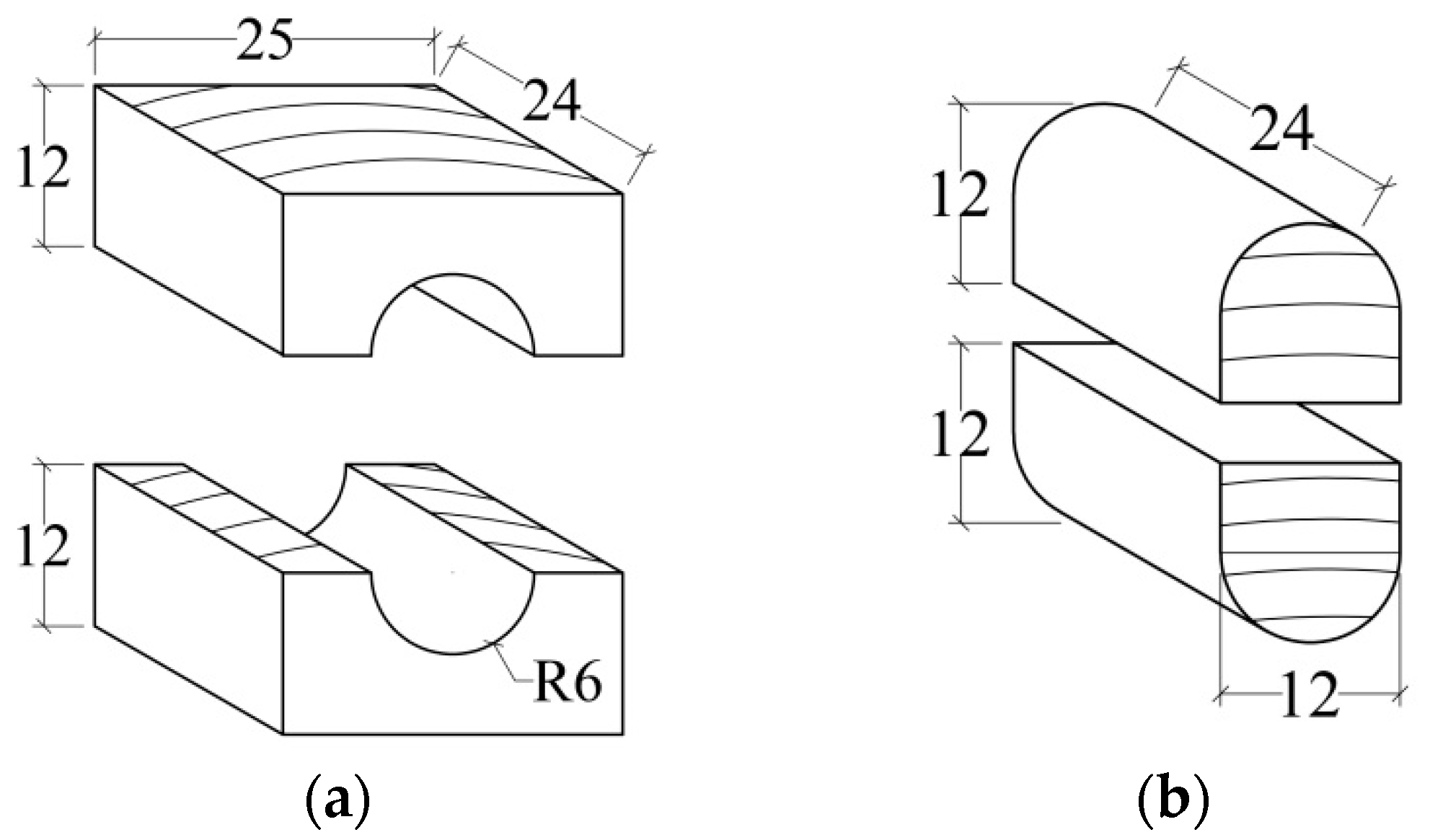


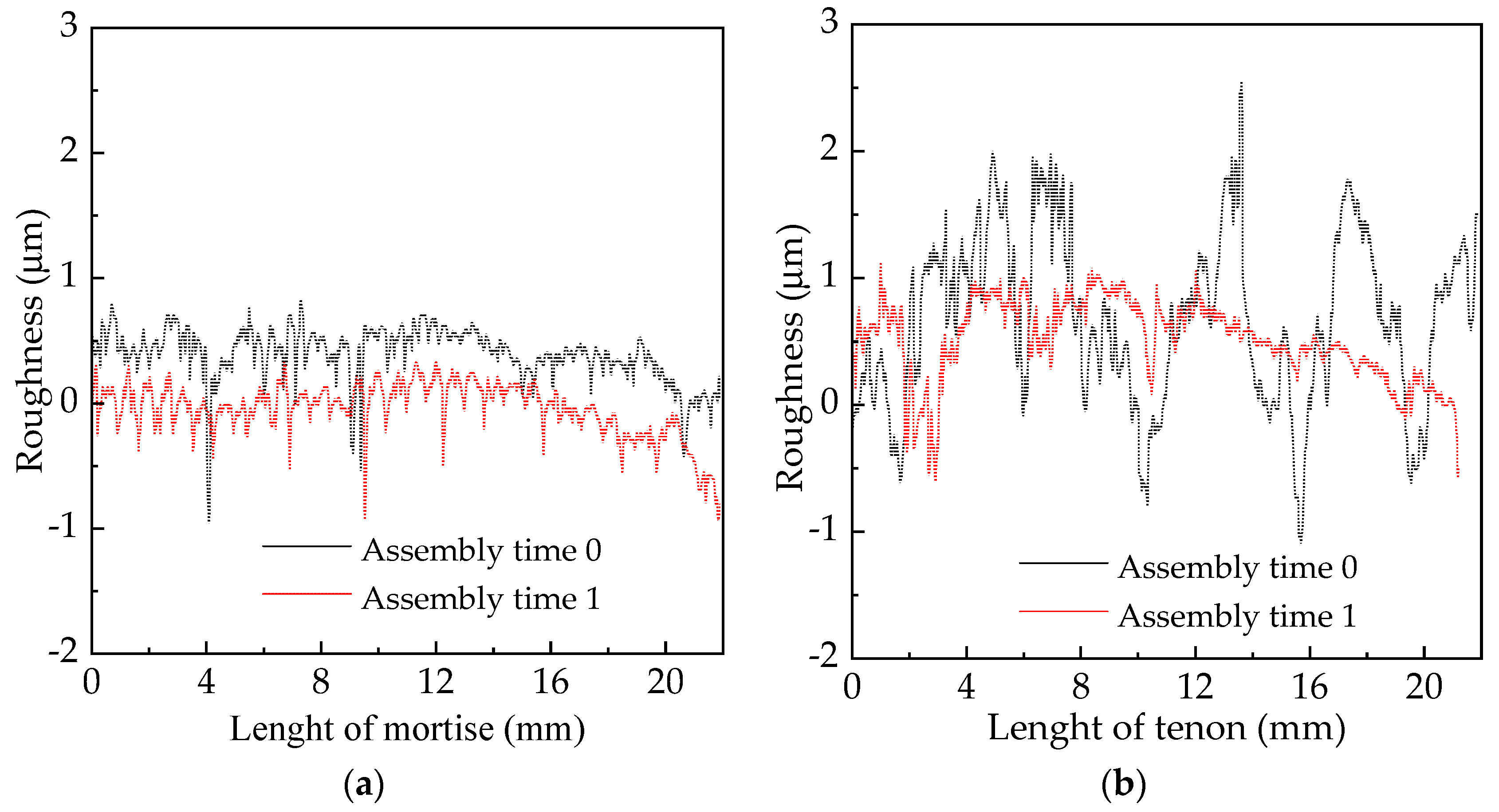

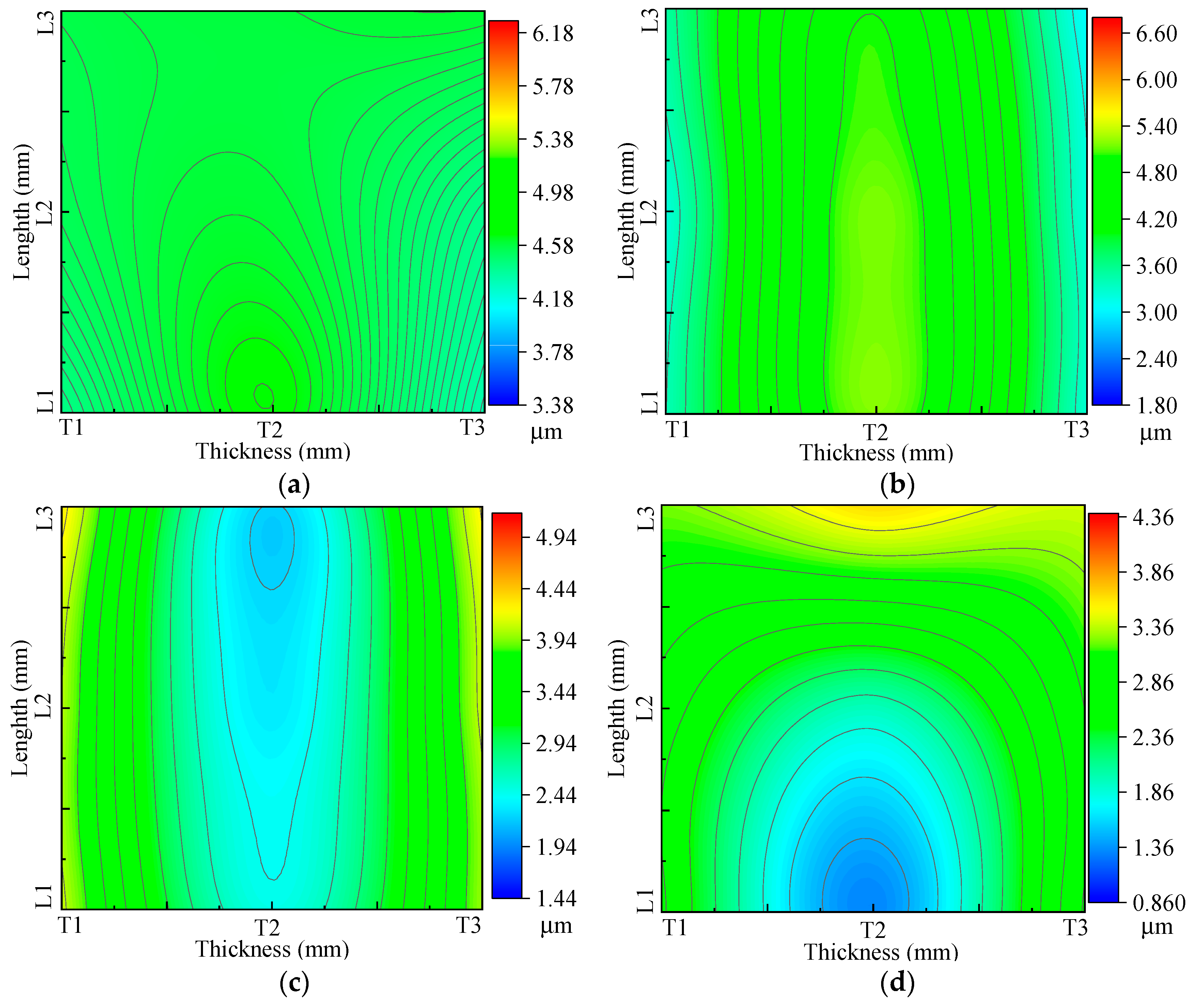
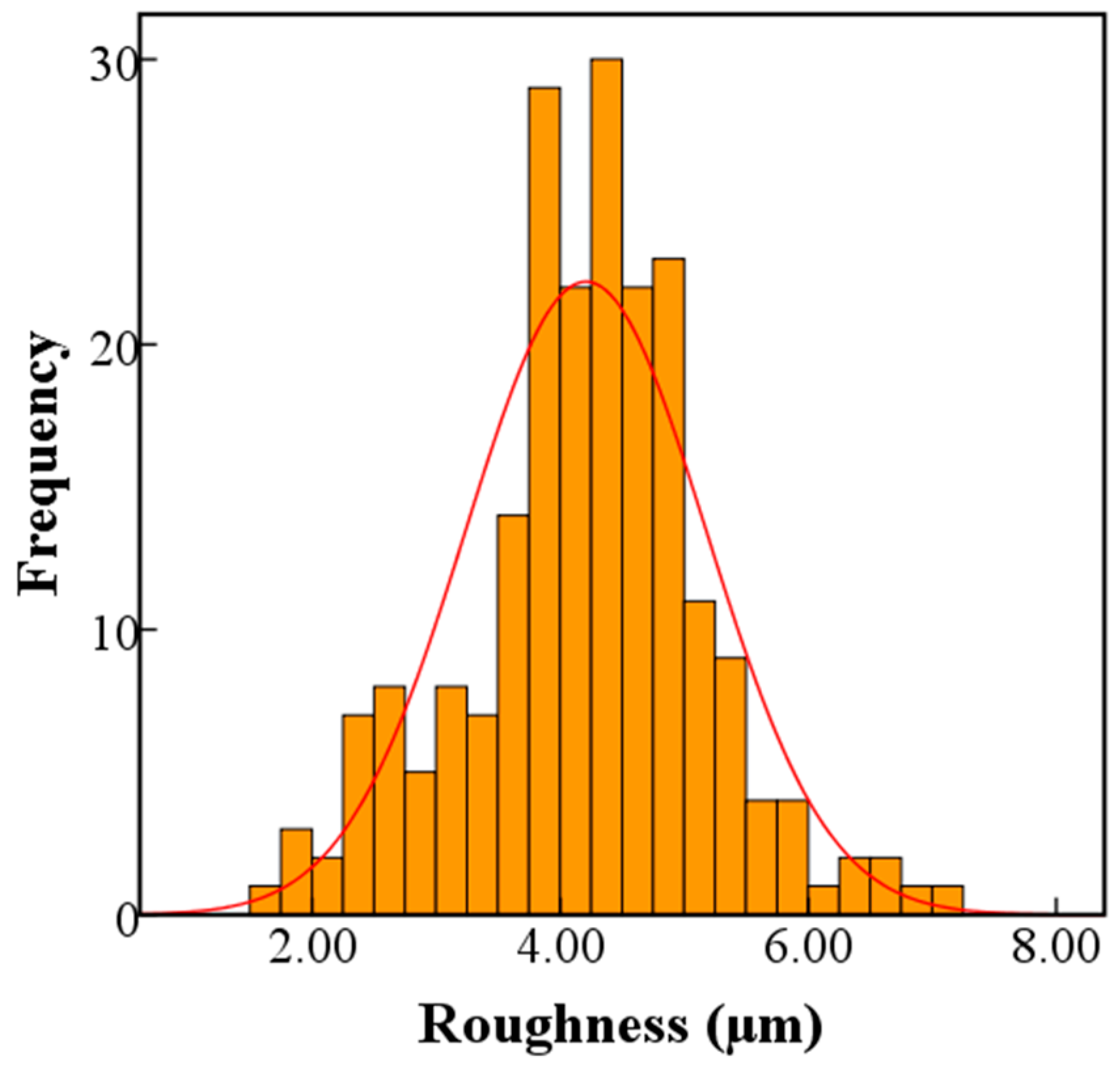
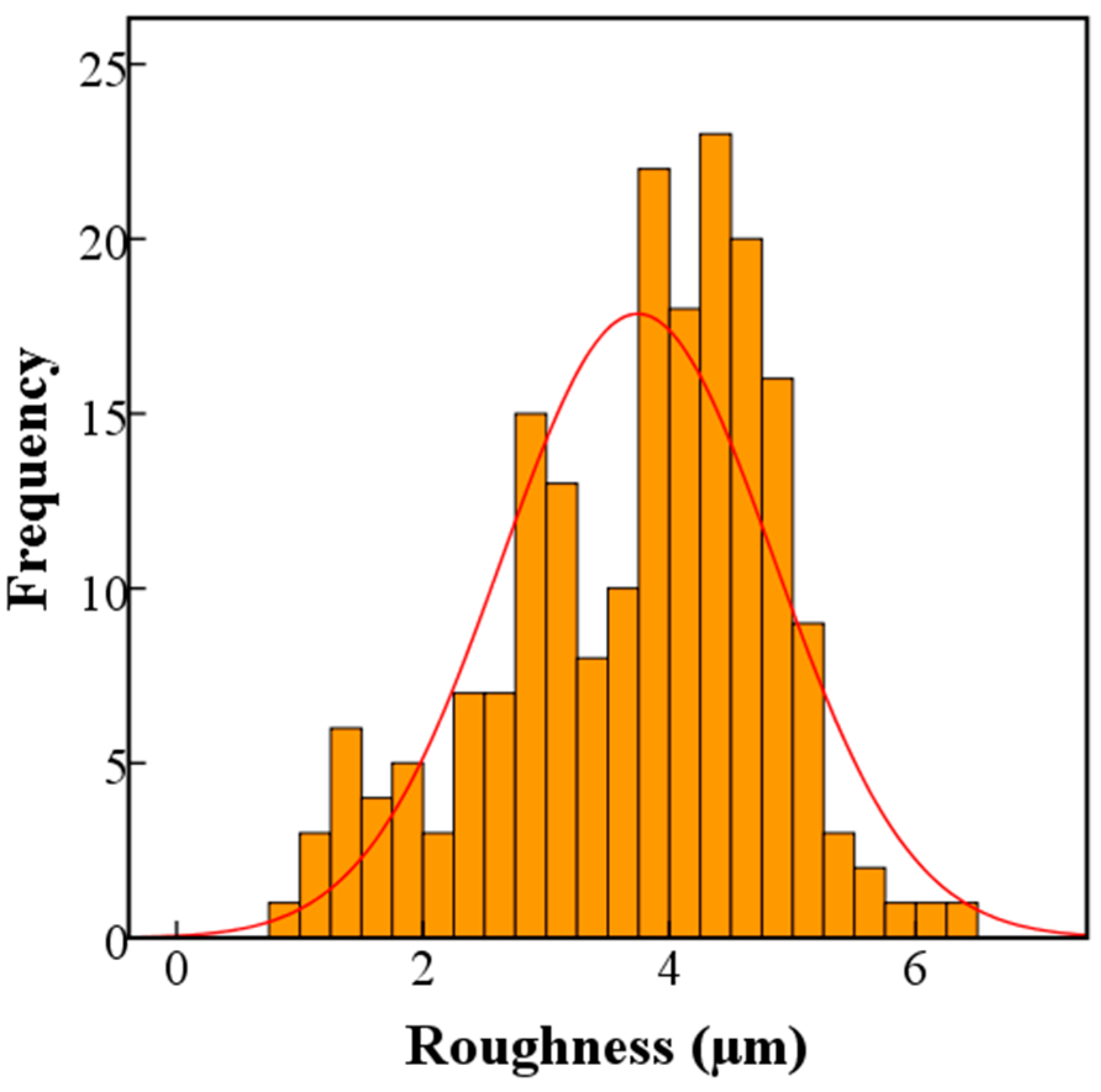
| Sources | F-Value | p-Value |
|---|---|---|
| Sample type (S) | 45.6 | <0.001 * |
| Thickness direction (T) | 48.0 | <0.001 * |
| Length direction (L) | 0.013 | 0.987 |
| S × T | 35.2 | <0.001 * |
| S × L | 0.421 | 0.657 |
| T × L | 0.256 | 0.906 |
| S × T × L | 0.381 | 0.822 |
| Length Direction | Thickness Direction | Sample Type | |
|---|---|---|---|
| Tenon | Mortise | ||
| L1 | T1 | 3.39 (18.7) Bb | 4.43 (8.3) Aa |
| T2 | 5.17 (16.1) Aa | 4.67 (11.3) Aa | |
| T3 | 3.27 (27.1) Bb | 4.33 (13.1) Aa | |
| L2 | T1 | 3.24 (20.2) Bb | 4.54 (9.6) Aa |
| T2 | 5.16 (20.4) Ba | 4.60 (13.6) Aa | |
| T3 | 3.22 (25.7) Bb | 4.42 (12.5) Aa | |
| L3 | T1 | 3.50 (22.5) Bb | 4.57 (9.29) Aa |
| T2 | 4.99 (19.0) Aa | 4.59 (15.0) Aa | |
| T3 | 3.04 (23.8) Bb | 4.61 (13.5) Aa | |
| Sources | F-Value | p-Value |
|---|---|---|
| Assembly condition (A) | 527.2 | <0.001 * |
| Thickness direction (T) | 7.6 | <0.001 * |
| Length direction (L) | 21.7 | <0.001 * |
| A × T | 16.5 | <0.001 * |
| A × L | 14.5 | <0.001 * |
| T × L | 4.4 | 0.002 * |
| A × T × L | 7.9 | <0.001 * |
| Length Direction | Thickness Direction | Assembly Condition | Reducing Ratio (%) | |
|---|---|---|---|---|
| Unassembled | Assembled | |||
| L1 | T1 | 3.39 (18.7) Ab | 2.69 (19.6) Ba | 20.7 |
| T2 | 5.17 (16.1) Aa | 1.33 (15.1) Bb | 74.3 | |
| T3 | 3.27 (27.1) Ab | 3.09 (18.3) Ba | 5.7 | |
| L2 | T1 | 3.24 (20.2) Ab | 2.78 (21.4) Ba | 14.1 |
| T2 | 5.16 (20.4) Aa | 1.97 (22.0) Bb | 61.8 | |
| T3 | 3.22 (25.7) Ab | 3.06 (14.5) Ba | 4.9 | |
| L3 | T1 | 3.50 (22.5) Ab | 3.23 (16.7) Ba | 7.9 |
| T2 | 4.99 (19.0) Aa | 3.63 (15.9) Ba | 27.1 | |
| T3 | 3.04 (23.8) Ab | 2.90 (10.5) Ba | 4.6 | |
| Thickness Direction | Assembly Condition | Length Direction | ||
|---|---|---|---|---|
| L1 | L2 | L3 | ||
| T1 | Unassembled | 3.39 (18.7) A | 3.24 (20.2) A | 3.50 (22.5) A |
| Assembled | 2.69 (19.6) B | 2.78 (21.4) B | 3.23 (16.7) A | |
| T2 | Unassembled | 5.17 (16.1) A | 5.16 (20.4) A | 4.99 (19.0) A |
| Assembled | 1.33 (15.1) C | 1.97 (22.0) B | 3.63 (15.9) A | |
| T3 | Unassembled | 3.27 (27.1) A | 3.22 (25.7) A | 3.04 (23.8) A |
| Assembled | 3.09 (18.3) A | 3.06 (14.5) A | 2.90 (10.5) A | |
Disclaimer/Publisher’s Note: The statements, opinions and data contained in all publications are solely those of the individual author(s) and contributor(s) and not of MDPI and/or the editor(s). MDPI and/or the editor(s) disclaim responsibility for any injury to people or property resulting from any ideas, methods, instructions or products referred to in the content. |
© 2024 by the authors. Licensee MDPI, Basel, Switzerland. This article is an open access article distributed under the terms and conditions of the Creative Commons Attribution (CC BY) license (https://creativecommons.org/licenses/by/4.0/).
Share and Cite
Hu, W.-G.; Yu, R.-Z.; Yang, P. Characterizing Roughness of Wooden Mortise and Tenon Considering Effects of Measured Position and Assembly Condition. Forests 2024, 15, 1584. https://doi.org/10.3390/f15091584
Hu W-G, Yu R-Z, Yang P. Characterizing Roughness of Wooden Mortise and Tenon Considering Effects of Measured Position and Assembly Condition. Forests. 2024; 15(9):1584. https://doi.org/10.3390/f15091584
Chicago/Turabian StyleHu, Wen-Gang, Run-Zhong Yu, and Peng Yang. 2024. "Characterizing Roughness of Wooden Mortise and Tenon Considering Effects of Measured Position and Assembly Condition" Forests 15, no. 9: 1584. https://doi.org/10.3390/f15091584






